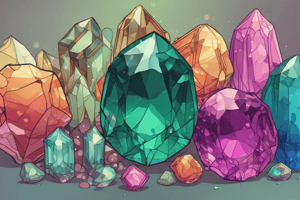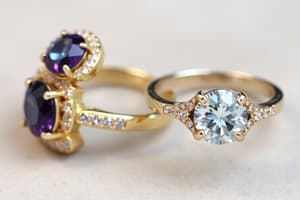Podcast
Questions and Answers
Which gemstone setting provides excellent protection for the gemstone while creating a smooth, flush surface?
Which gemstone setting provides excellent protection for the gemstone while creating a smooth, flush surface?
- Prong Setting
- Channel Setting
- Bar Setting
- Bezel Setting (correct)
What is a characteristic of the Channel Setting?
What is a characteristic of the Channel Setting?
- It utilizes metal claws to hold the gemstone by tension.
- It securely grips the gemstone with prongs on the side.
- It is primarily designed for smaller gemstones.
- It fits the gemstone within a long groove for enhanced support. (correct)
Which setting is particularly suitable for gemstones with delicate characteristics that should not be overtly showcased?
Which setting is particularly suitable for gemstones with delicate characteristics that should not be overtly showcased?
- Bezel Setting (correct)
- Invisible Setting
- Prong Setting
- Basket Setting
What gemstone shapes are most commonly associated with the爪 (tension) setting?
What gemstone shapes are most commonly associated with the爪 (tension) setting?
Which type of setting is known for surrounding the gemstone from all sides, providing excellent security?
Which type of setting is known for surrounding the gemstone from all sides, providing excellent security?
What is a primary advantage of using a bezel setting for gemstones?
What is a primary advantage of using a bezel setting for gemstones?
Which setting type is characterized by its ability to showcase a cluster of multiple gemstones?
Which setting type is characterized by its ability to showcase a cluster of multiple gemstones?
What factor most directly influences the choice of setting for a gemstone?
What factor most directly influences the choice of setting for a gemstone?
Which setting type is known for its unique visual focus and open design?
Which setting type is known for its unique visual focus and open design?
What consideration is vital to ensure both durability and security when selecting a gemstone setting?
What consideration is vital to ensure both durability and security when selecting a gemstone setting?
Flashcards
Prong Setting
Prong Setting
A setting that grips the gemstone with several metal prongs around its edges or base.
Bezel Setting
Bezel Setting
A setting that surrounds the gem with a raised metal rim encompassing most of the stone. It creates a flush or low-profile appearance.
Bar Setting
Bar Setting
A setting that uses a metal bar to hold the gem securely, often used for long or rectangular shaped gemstones.
Channel Setting
Channel Setting
Signup and view all the flashcards
Invisible Setting
Invisible Setting
Signup and view all the flashcards
Gemstone Setting
Gemstone Setting
Signup and view all the flashcards
Gypsy Setting
Gypsy Setting
Signup and view all the flashcards
Mikado Setting
Mikado Setting
Signup and view all the flashcards
Cluster Setting
Cluster Setting
Signup and view all the flashcards
Setting Choice Factors
Setting Choice Factors
Signup and view all the flashcards
Study Notes
Introduction to Gemstone Setting Types
- Gemstone settings are crucial for protecting and showcasing the gem, influencing its aesthetic appeal and longevity.
- Various settings exist, each with unique characteristics and purposes.
- The choice of setting depends on the gemstone's cut, shape, and size, as well as the desired aesthetic.
Prong Setting
- Securely holds the gemstone with several metal prongs (typically four or six) that grip it from the side or base.
- Offers excellent visibility of the gemstone's surface.
- Prone to damage if not properly fitted.
- Suited to various gemstones, including round brilliants and fancy shapes.
Bezel Setting
- Embeds the gemstone in a metal rim, creating a smooth, flush surface.
- Provides excellent protection for the gemstone.
- Conceals more of the metal, leading to a more understated look.
- Particularly suitable for gemstones with facets that aren't desirable to showcase overtly or those with delicate characteristics.
Bar Setting
- A simple setting style that involves using a metal bar to hold the stone.
- Holds the gemstone securely.
- Provides an elegant, linear aesthetic.
- Often used for elongated or rectangular gemstones (e.g. emeralds).
Channel Setting
- The gemstone fits within a long groove or channel, typically of metal, along the length or perimeter of the piece.
- Offers ample support for the gem but can be prone to damage if not appropriately fitted.
- Provides a cohesive aesthetic and is commonly used to display multiple gemstones.
###爪 Setting /爪 Setting
- The爪 (Chinese character) setting is also called a "tension setting".
- It uses metal claws to hold the gemstone in place, by the use of tension.
- The setting is known for its unique look and is most often used for special cut or shaped gemstones such as pear, marquise, or other unusual shapes.
- Often used for more intricate or unusual-shaped stones, resulting in a more noticeable aesthetic element.
Basket Setting
- A type of setting that surrounds the gem from all sides, in a somewhat basket- or cup-like holder.
- Provides excellent security for gemstones, especially those prone to chipping.
- Ideal for smaller or less flawless gemstones.
- Can sometimes accentuate the beauty of the gem because of the way the surrounding frame or basket setting holds it.
Invisible Setting (Under-table Setting)
- The gemstone's base is completely concealed under the metal, creating a virtually invisible setting.
- Provides an uninterrupted, smooth surface, highlighting the gemstone's facets and shape.
- Offers exceptional security, making it suitable for delicate gemstones.
- Often employed for gemstones of high value or ones requiring maximum protection.
Other Setting Types - Specific examples and descriptions.
- Gypsy Setting: Combines several setting techniques, such as prongs and bezels.
- Mikado Setting: Known for its open design and fine construction, usually highlighting the gem and creating a unique visual focus.
- Cluster Setting: Involves multiple gemstones, often of different shapes and sizes, set together in a surrounding metal, thus creating a cluster.
Factors Influencing Setting Choice
- Gemstone characteristics (cut, shape, size, hardness): The type of stone dictates which setting is most suitable.
- Desired aesthetic: This influences the preference for visible metal or a more hidden setting
- Setting's structural integrity Durability and security are paramount, especially with gemstones prone to damage
- Metal type and color: The setting metal should compliment both the gemstone and intended design.
Studying That Suits You
Use AI to generate personalized quizzes and flashcards to suit your learning preferences.




